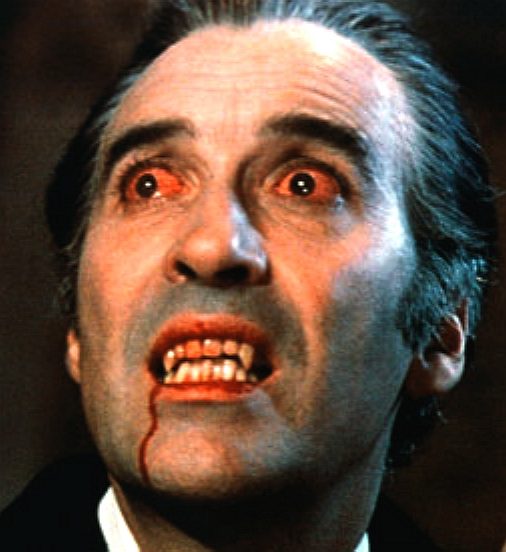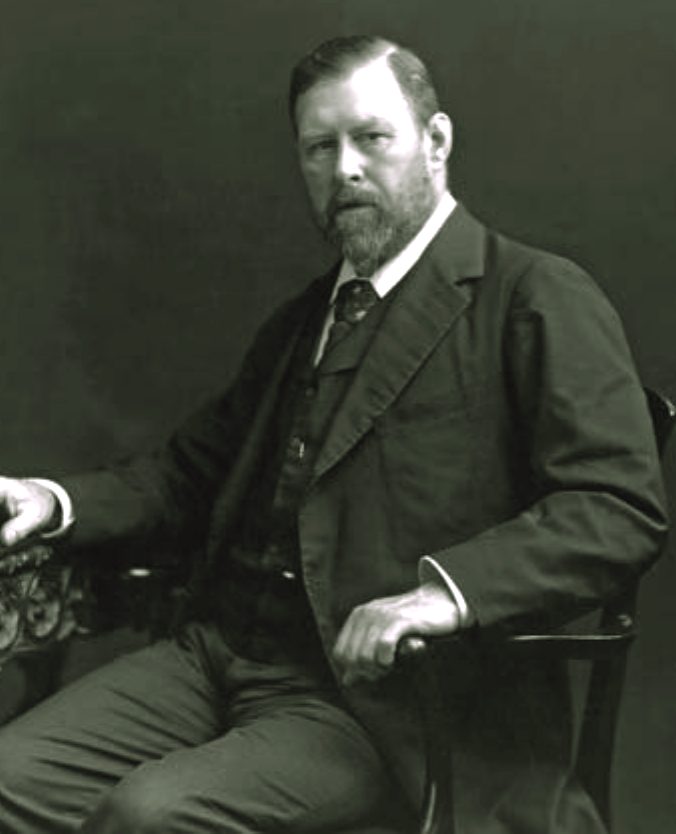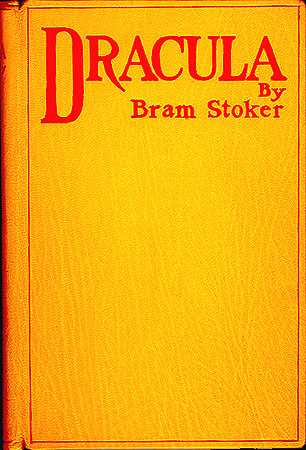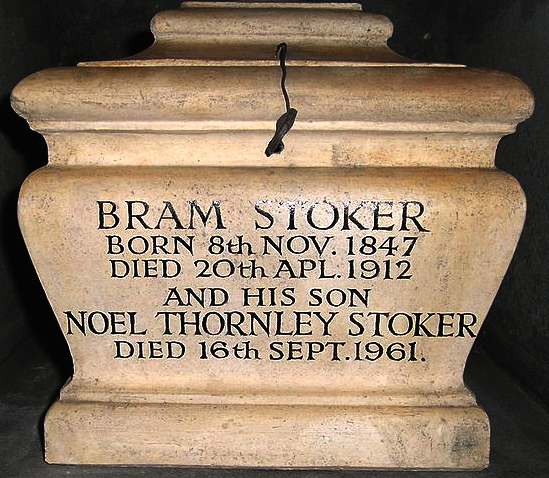|
Abraham "Bram" Stoker (8 November 1847 – 20 April 1912) was an
Irish novelist and short story writer, best known today for his 1897 Gothic novel Dracula. During his lifetime, he was better known as personal assistant of actor Henry Irving and business manager of the Lyceum Theatre in
London, which Irving owned.

Early life
Stoker was born on 8 November 1847 at 15 Marino Crescent, Clontarf, on the northside of Dublin,
Ireland. His parents were Abraham Stoker (1799–1876), from Dublin, and Charlotte Mathilda Blake Thornley (1818–1901), who came from Ballyshannon, County Donegal. Stoker was the third of seven
children. Abraham and Charlotte were members of the Church of Ireland Parish of Clontarf and attended the parish church with their children, who were baptised there.
Stoker was bed-ridden until he started school at the age of seven, when he made a complete recovery. Of this time, Stoker wrote, "I was naturally thoughtful, and the leisure of long illness gave opportunity for many thoughts which were fruitful according to their kind in later years." He was
educated in a private
school run by the Rev. William
Woods.
After his recovery, he grew up without further major health issues, even excelling as an athlete (he was named University Athlete) at Trinity
College, Dublin, which he attended from 1864 to 1870. He graduated with honours in mathematics. He was auditor of the College Historical Society and president of the University Philosophical Society, where his first paper was on "Sensationalism in Fiction and Society".
Early career
Stoker became interested in the theatre while a student through a friend, Dr. Maunsell. He became the theatre critic for the Dublin Evening Mail, co-owned by the author of Gothic tales Joseph Sheridan Le Fanu. Theatre critics were held in low esteem but he attracted notice by the quality of his reviews. In December 1876 he gave a favourable review of Henry Irving's Hamlet at the Theatre Royal in Dublin. Irving invited Stoker for dinner at the Shelbourne Hotel, where he was staying. They became friends. Stoker also wrote stories, and in 1872 "The Crystal Cup" was published by the London Society, followed by "The Chain of Destiny" in four parts in The Shamrock. In 1876, while a civil servant in Dublin, Stoker wrote a non-fiction book (The Duties of Clerks of Petty Sessions in Ireland, published 1879), which remained a standard work. Furthermore, he possessed an interest in art, and was a founder of the Dublin Sketching Club in
1874.

Lyceum Theatre and later career
In 1878 Stoker married Florence Balcombe, daughter of Lieutenant-Colonel James Balcombe of 1 Marino Crescent. She was a celebrated beauty whose former suitor was Oscar
Wilde. Stoker had known Wilde from his student days, having proposed him for membership of the university’s Philosophical Society while he was president. Wilde was upset at Florence's decision, but Stoker later resumed the acquaintanceship, and after Wilde's fall visited him on the
Continent.
The Stokers moved to London, where Stoker became acting manager and then business manager of Irving's Lyceum Theatre, London, a post he held for 27 years. On 31 December 1879, Bram and Florence's only child was born, a son whom they christened Irving Noel Thornley Stoker. The collaboration with Irving was important for Stoker and through him he became involved in London's high society, where he met James Abbott McNeill Whistler and Sir Arthur Conan Doyle (to whom he was distantly related). Working for Irving, the most famous actor of his time, and managing one of the most successful theatres in London made Stoker a notable if busy man. He was dedicated to Irving and his memoirs show he idolised him. In London Stoker also met Hall Caine who became one of his closest friends - he dedicated Dracula to him.
In the course of Irving's tours, Stoker travelled the world, although he never visited Eastern
Europe, a setting for his most famous novel. Stoker enjoyed the United States, where Irving was popular. With Irving he was invited twice to the
White
House, and knew William McKinley and Theodore
Roosevelt. Stoker set two of his novels there, using Americans as characters, the most notable being Quincey Morris. He also met one of his literary idols, Walt Whitman.

Writings
While manager for Irving, and secretary and director of London's Lyceum Theatre, he began writing novels beginning with The Snake's Pass in 1890 and Dracula in 1897. During this period, Stoker was part of the literary staff of the London
Daily Telegraph and wrote other fiction, including the horror novels The Lady of the Shroud (1909) and The Lair of the White Worm
(1911). In 1906, after Irving's death, he published his life of Irving, which proved
successful, and managed productions at the Prince of Wales Theatre.
Before writing Dracula, Stoker spent several years researching European folklore and mythological stories of vampires. Dracula is an epistolary novel, written as a collection of realistic, but completely fictional, diary entries, telegrams, letters, ship's logs, and newspaper clippings, all of which added a level of detailed realism to his story, a skill he developed as a newspaper writer.
At the time of its publication, Dracula was considered a "straightforward horror novel" based on imaginary creations of supernatural
life. "It gave form to a universal fantasy . . . and became a part of popular
culture."
According to the Encyclopedia of World Biography, Stoker's stories are today included within the categories of "horror fiction," "romanticized Gothic" stories, and
"melodrama." They are classified alongside other "works of popular fiction" such as Mary Shelley's
Frankenstein:394 which, according to historian Jules Zanger, also used the "myth-making" and story-telling method of having "multiple narrators" telling the same tale from different perspectives. "'They can't all be lying,' thinks the
reader."

The original 541-page manuscript of Dracula, believed to have been lost, was found in a barn in northwestern
Pennsylvania during the early
1980s. It included the typed manuscript with many corrections, and handwritten on the title page was "THE UN-DEAD." The author's name was shown at the bottom as Bram Stoker. Author Robert Latham notes, "the most famous horror novel ever published, its title changed at the last
minute.". The manuscript was purchased by Microsoft co-founder Paul Allen.
Stoker's inspirations for the story, in addition to Whitby, may have included a visit to Slains Castle in Aberdeenshire, a visit to the crypts of St. Michan's Church in Dublin and the novella Carmilla by Joseph Sheridan Le
Fanu.
Stoker's original research notes for the novel are kept by the Rosenbach Museum and Library in Philadelphia, PA. A facsimile edition of the notes was created by Elizabeth Miller and Robert Eighteen-Bisang in 1998.
Death
After suffering a number of strokes, Stoker died at No. 26 St George's Square on 20 April
1912. Some biographers attribute the cause of death to tertiary syphilis, others to
overwork. He was cremated, and his ashes placed in a display urn at Golders Green Crematorium. After Irving Noel Stoker's death in 1961, his ashes were added to that urn. The original plan had been to keep his parents' ashes together, but after Florence Stoker's death, her ashes were scattered at the Gardens of Rest. To visit his remains at Golders Green, visitors must be escorted to the room the urn is housed in, for fear of vandalism.

Beliefs and philosophy
Stoker was brought up as a Protestant, in the Church of Ireland. He was a strong supporter of the Liberal party. He took a keen interest in Irish
affairs and was what he called a "philosophical home ruler", believing in Home Rule for Ireland brought about by peaceful means - but as an ardent monarchist he believed that Ireland should remain within the
British Empire which he believed was a force for good. He was a great admirer of Prime Minister William Ewart Gladstone whom he knew personally, and admired his plans for
Ireland.
Stoker had a strong interest in science and medicine and a belief in progress. Some of his novels like The Lady of the Shroud (1909) can be seen as early science fiction.
Stoker had an interest in the occult especially mesmerism, but was also wary of occult fraud and believed strongly that superstition should be replaced by more scientific ideas. In the mid 1890s, Stoker is rumoured to have become a member of the Hermetic Order of the
Golden
Dawn, though there is no concrete evidence to support this
claim. One of Stoker's closest friends was J.W. Brodie-Innis, a major figure in the Order, and Stoker himself hired Pamela Coleman Smith, as an artist at the Lyceum Theater.
Posthumous
The short story collection Dracula's Guest and Other Weird Stories was published in 1914 by Stoker's widow Florence Stoker. The first film adaptation of Dracula was released in 1922 and was named Nosferatu. It was directed by Friedrich Wilhelm Murnau and starred Max Schreck as Count Orlock. Nosferatu was produced while Florence Stoker, Bram Stoker's widow and literary executrix, was still alive. Represented by the attorneys of the British Incorporated Society of Authors, she eventually sued the filmmakers. Her chief legal complaint was that she had been neither asked for permission for the adaptation nor paid any
royalty. The case dragged on for some years, with Mrs. Stoker demanding the destruction of the negative and all prints of the film. The suit was finally resolved in the widow's favour in July 1925. Some copies of the film survived, however and the film has become well known.
The first authorised film version of Dracula did not come about until almost a decade later when
Universal Studios released Tod Browning's Dracula starring Bela
Lugosi.
Because of the Stokers' frustrating history with Dracula's copyright, a great-grandnephew of Bram Stoker,
Canadian writer Dacre Stoker, with encouragement from screenwriter Ian Holt, decided to write "a sequel that bore the Stoker name" to "reestablish creative control over" the original novel. In 2009, Dracula: The Un-Dead was released, written by Dacre Stoker and Ian Holt. Both writers "based [their work] on Bram Stoker's own handwritten notes for characters and plot threads excised from the original edition" along with their own research for the sequel. This also marked Dacre Stoker's writing
debut.
In Spring 2012, Dacre Stoker in collaboration with Prof. Elizabeth Miller presented the "lost" Dublin Journal written by Bram Stoker, which had been kept by his great-grandson Noel Dobbs. Stoker's diary entries shed a light on the issues that concerned him before his
London years. A remark about a boy who caught flies in a bottle might be a clue for the later development of the Renfield character in Dracula.

PLOT
OUTLINE This original story is part of the John Storm series of ocean adventures. John, as a Blue Shield operative, surveys the sunken city of Alexandria recently disturbed by earthquake, and finally finds Cleopatra's mummy. Swiss Professor Dr Krafenstein (Wealthy Baron Victor Frankenstein VI under his assumed name) working in Zurich has secretly developed a technique for replicating humans, made possible having purchased the CyberCore Genetica™ from William Bates (Billy the Kid). The Professor, along with others have refined a CRISPR virus that enhances human DNA, having surpassed known cloning techniques. This cohort have also perfected an organic chip, that interfaces with the brain called BioCore™. Professor Krafenstein persuades John Storm to supply a sample of Cleopatra's DNA, for the ETH University to run further investigations as to Macedonian lineage. But he oversteps the mark, breaching agreement with John as to use of Cleo's DNA.
CLEOPATRA'S
MUMMY & COUNT DRACULA'S CURE FOR CANCER: THE PERFECT PLOT (SHORT STORY)
SCENE
1. Cleopatra's
tomb lay lost for centuries. Then one day a shift in the tectonic plates
triggered a tremor off the coast of Alexandria,
causing alarm in Paris. (Flashback: The destruction of Thonis &
Alexandria by a tsunami,
sinking the great civilization and port in 365 AD.)
SCENE
2. As
an agent of Blue
Shield, John
Storm, surveys Egypt's coast off
Alexandria, finds Cleopatra's tomb, verified using the Ark and Hal, keeping
location a secret, pending salvage and Blue Shield site protections.
SCENE
3. John
reads a letter from Cleopatra to Mark
Antony from Cleopatra’s mausoleum, 30 BC, the
combined suicide of Marcus
Antonius and Cleopatra, a death wish
love pact.
SCENE
4. William
Bates auctions his CyberCore Genetica nano-super
computer. Secretly purchased by the wealthy Professor Krafenstein, via an
anonymous sealed bid. This acquisition helps Victor secure loyal
collaborators.
SCENE
5. A
team of European scientists, including Franco
Francisco, are gathered together and funded by the wealthy Baron as
cloning technology champions, regardless of potential illegality or ethical
consideration. Though, Replication and gene manipulations treatments are
held to be legal by the cohort.
SCENE
6. As
part of their human enhancement regime, ingredients of the CRISPR virus,
a bacterial DNA Cas9 enzyme delivery system, that allows precisely targeted
DNA enhancement in adult subjects, is developed as cousin technology. Made
possible by the CyberCore computer. The team realise that this could form
the basis of a cure
for cancer.
SCENE
7. Charley
Temple alerts
John Storm to the consequences of the joining of dots of the technology that
Professor Krafenstein and his partners are working on. She is being fed
information from, and nurturing contacts at the ETH university in Zurich.
With Sam Hollis being in contact with Colonial athletes in attendance. Some
of which have given blood samples, in connection with the Baron's research.
SCENE
8. John
is courted by Jack
Mason, purporting to represent the USA, asking for his help in their
investigations into cyber crime, and technology that might one day pose a
threat to international stability.
SCENE
9. Storm
is asked by Professor
Krafenstein to relinquish a small Cleopatra tissue
sample. The carrot is that their cohort will share their DNA archive, to add
to John's collection.
SCENE
10. John
relents, persuaded by Blue Shield. The knowledge transfer (swapsie) proves
to be irresistible to John.
SCENE
11. Having
taken delivery of a sample of Cleopatra's DNA,
Professor Krafenstein perfects his replication
technique, after one or two costly mistakes.
SCENE
12. The
scientists develop a prototype biological implant, an interface for the human
brain, which they call BioCore™.
This flexible microchip communicates wirelessly with the CyberCore Genetica,
and from there to the internet. They are streets ahead of a system developed
by Elon
Musk, some years earlier.
SCENE
13. The
Birth. Replication work proceeds, with Cleopatra grown and her brain
programmed (conditioned) with her past, to include simulation of her synapse
firing sequence, based on the fact she spoke nine languages, and was a
mathematician and an accomplished political and military strategist. Other
elements are included to soften the culture shock, as the reincarnated queen
re-enters life in the 21st century, the prophesy of her reincarnation comes
true. Charley gets wind of strange goings on between Zurich
and Genoa, and alerts John.
SCENE
14. John
requests a visit to check out the notion that cloning might be on Professor
Krafenstein's agenda, but is given the brush off, and shown a facility that
does not seem to have all the equipment necessary to have cloned or
otherwise experimented on humans, much to his relief. But rumors of a clone
persist, which John senses could be Cleopatra. Then he is denied access to
the subject with various excuses, that do not gel. His suspicions are
aroused, and he investigates further with help from Dan (hacking) and Hal.
SCENE
15. Charley
persists with her own investigations, agreeing to meet with John, where she
thinks the real work is going on convenient to the ancient port of Genoa, Italy.
While checking out a laboratory, she is captured, and John has to effect a
rescue, with some background intelligence from the CIA's Jack Mason. During
the struggle to overpower Charley's captors, John is injected with an
experimental CRISPR virus.
Dan manages to make off with the CyberCore Genetica and Biocore,
equipment, plus a download of all the experimental files. Jack Mason turns a
blind eye, biding his time.
SCENE
16. From
the recovered data, Dan and Hal work out that Cleopatra does exists, and is
being repatriated in a secure facility in Rome, where the former queen had
visited with Julius
Caesar in 46BC.
John raids their sanctuary just outside the city, rescuing/freeing Cleopatra
in the process, with Interpol questioning all the wrong people, on suspicion
of kidnap. Cleopatra expresses a wish to be with John Storm, who she
instinctively trusts implicitly, leaving Interpol and Blue Shield, little
choice in the matter. And Jack Mason with a problem. He was hoping to
acquire Cleopatra in all the confusion. But Cleopatra reveals that Dr
Krafenstein had given her, her freedom. She was free to leave whenever she
felt ready.
SCENE
17. Jack
Mason continues to plot to part John
Storm from the CRISPR technology, and kidnap Cleopatra
on grounds of homeland security, looking to take control of the replication
technology. As the official US representative, he talks John and Cleopatra
into the replicant queen having a check up at Uncle Sam's expense at a
private hospital in Egypt, to coincide with the unveiling of the Cleopatra
VII mummy exhibits
in Cairo and Giza.
Though a disingenuous ruse, Cleopatra agrees, just to please John. She is
curious to see what her own mummy looks like as an exhibition of her past
glory.
SCENE
18. Storm
is double crossed by Jack Mason, who spirits Cleopatra overseas to the
secure US facility at Guantánamo Bay. Way off the beaten track, and
extremely well guarded. Such military location eliminating any chance of a
rescue.
SCENE
19. Despite
the obstacles, John
Storm rescues Cleopatra from Guantánamo
Bay in a daring night raid.
SCENE
20 CIA,
covertly try to terminate the Swann and crew, including Cleopatra, who is
now a witness to their evils.
SCENE
21. John
does a deal with US
President
Lincoln Truman, Jack Mason is chastised.
NOVELIST
INDEX
A - Z
GRAPHIC
NOVEL INDEX
A - Z
|
Bram
Stoker's Dracula
- Youtube
|
Lugosi
1931 - Youtube
|
|
Christopher
Lee
- Youtube
|
Dracula
Prince of Darkness - Youtube
|
LINKS:
Bram
Stoker at the Open Directory
Project
Bram
Stoker at the Internet
Movie Database
h2g2
article on Bram Stoker
Bram
Stoker's brief biography and works
20
Common Misconceptions and Other Miscellaneous Information
The
Stoker Dracula Organisation
Gothic
and Stoker Studies at Bath Spa University
Works
by Bram Stoker at Project Gutenberg Full text versions of some of
Stoker's novels.
Bram
Stoker Online Full text and PDF versions of most of Stoker's works.
Bram
Stoker's Dracula Full text of Stoker's novel Dracula.
Works
by Bram Stoker

A
heartwarming adventure: pirate
whalers V conservationists
|





